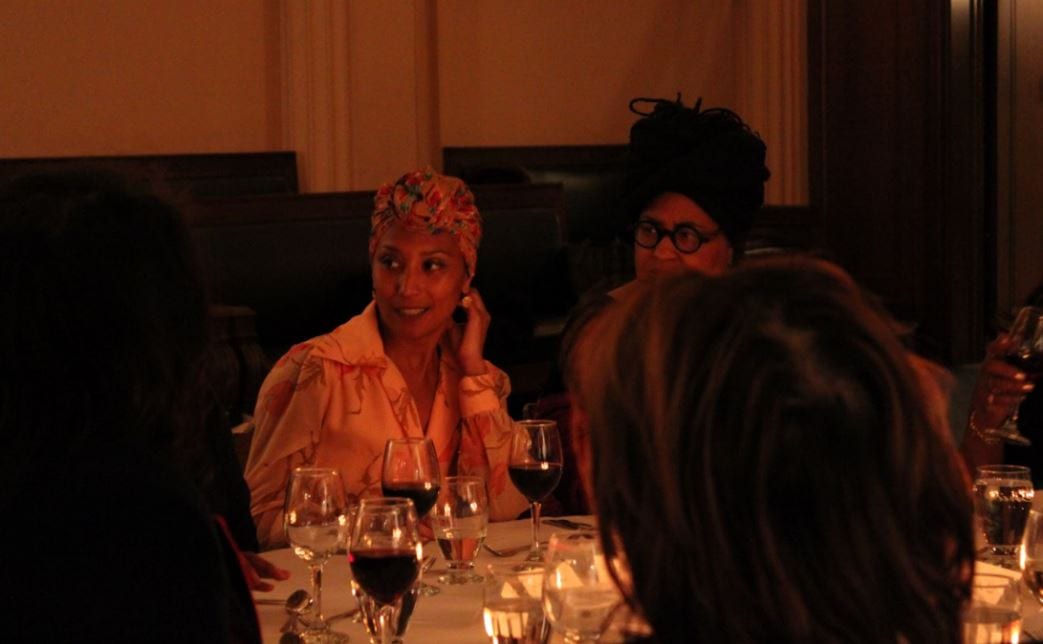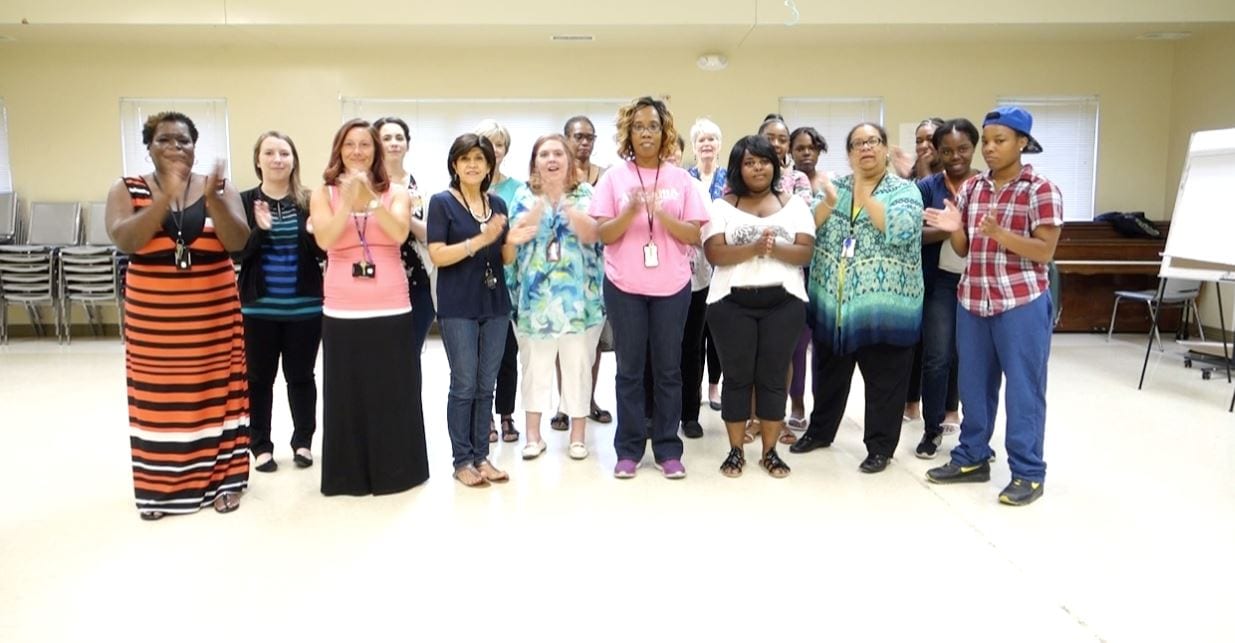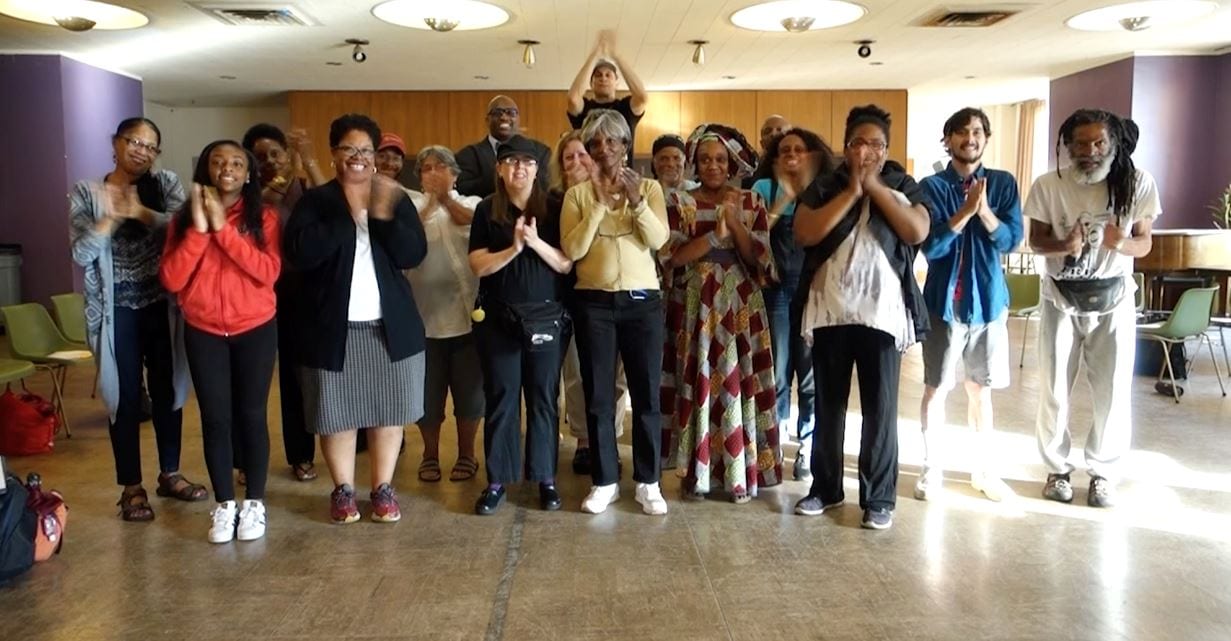
Film Still: Dancing in the Street, Chloë Brown, 2016
Since 2013 I have been working with what I term “Soft Rebellions” as a way of questioning the representation of certain post-industrial cities in relation to my position as a woman born and bred in the city of Sheffield in the UK; cities whose “reason for being”, their industry, has transformed so significantly that the use of their nicknames: “The Potteries” (Stoke-on-Trent, UK), “The Motor City (Detroit, USA), “The Steel City” (Sheffield, UK), becomes a melancholy gesture that talks about the past, not the now, nor the future.
“A Soft Rebellion” questions what happens when the economic engines of a city slow down but the people don’t. This research focuses particularly on the citizens, and asks this question with optimism by rejecting the production of “ruin porn” in favor of art work that is uplifting, celebratory, even life-affirming.
So far, the Soft Rebellions have been a series of actions and events that involve:
Dancing

Eating

Talking

And Applauding

in places where it is considered transgressive to do so.
Dancing in the Boardroom (Turnin’ My Heartbeat Up)

Film still: Dancing in the Boardroom (Turnin’ My Heartbeat Up), Chloë Brown, 2013
This film was the first work I made as a “Soft Rebellion”. It features two Northern Soul[1] dancers dancing with passion in the empty, once splendid Boardroom at the disused Spode ceramic factory in Stoke-on-Trent, UK. This leads to collisions of meaning, not least the questioning of the sanctity of the Boardroom, a place where traditionally the Managing Director and the Board would entertain buyers and guests. In the film, the room is transformed into a ballroom, a dance hall, where uplifting music is played and a couple dances, absorbed in their own movements and thoughts.
Through this film and its installation as part of the British Ceramics Biennial in the Managing Director’s office at the Spode Factory, issues such as the class system, labor and norms of behavior are questioned. Notions of the industrial ruin in combination with Stoke-on-Trent’s prominence in the history of the Northern Soul movement are explored through the film and make connections between Stoke-on-Trent and Detroit (from where the music largely originates). The work articulates with contemporary questions around site, dance, and music as a way of addressing emotional responses to particular places.
The film was originally made in response to the “Topographies of the Obsolete” research project (a site specific research collaboration between the British Ceramic Biennial, Sheffield Hallam University, Danske Kunstakademi, Copenhagen, Muthesius kunsthochschule, Kiel Germany, the Bergen Academy of Art and Design, Norway, Alfred University, USA University of Newcastle and the School of Art and Design, Nottingham Trent University since 2012)
Since August 2015, I have been visiting and working in Detroit to further extend this ongoing practice-based research. Detroit is renowned for being the epitome of a city in post-industrial crisis but my interest in the city extends to the development of soul music during the 1960s and 70s due to my previous research into Northern Soul. Utilizing artistic research methodologies I use this history to challenge, question and contribute to specific narratives within the city, working and collaborating with native Detroiters, including Martha Reeves, of seminal Motown group Martha and The Vandellas.
The film can be accessed here: https://vimeo.com/75807622
HD Video 2013
Duration: 07:37
From Alfred Street to Temple Street, Detroit

Detail: From Alfred Street to Temple Street, Detroit, Chloë Brown, 2015
Initially unable to visit the city, I began “walking” down the streets of Detroit via Google Maps Street View from my studio in Sheffield as a visual way of trying to understand the city from afar. This resulted in an ink drawing entitled “From Alfred Street to Temple Street, Detroit” which charts a route through Brush Park, starting at the scrub land where the Brewster Douglass Housing Projects used to stand before being demolished in 2013—a place that was the childhood home to many Motown stars including Diana Ross, and Mary Wilson, and Florence Ballard of the Supremes. The drawing is almost 9 meters or 30 feet in length and takes the form of a scroll that re-imagines the route as a topographical observation. It makes connections between the once grand houses at one end of the route, the empty plots and often derelict warehouses and factories in the middle, and world’s largest Masonic Temple at the other end, which for me symbolizes a secretive and exclusively male authority.
Ink Drawing, 2015
8 meters 81.4cm x 24.1cm
In the collection of The Detroit Institute of Arts (DIA), Detroit.

Installation view: From Alfred Street to Temple Street, Detroit, Chloë Brown, 2015
Exhibition: Dancing in the Boardroom, Museum of Contemporary Art Detroit (MOCAD), Jan-Apr 2016

Detail: From Alfred Street to Temple Street, Detroit, Chloë Brown, 2015
Dancing in the Street
In August 2015, I visited Detroit for the first time to make a short film collaborating with people from the city, filming them dancing along the route of my drawing From Alfred Street to Temple Street, Detroit¸ while listening to the song “Dancing in the Street” on headphones. The title of the film refers to this song by Martha Reeves and The Vandellas released by Motown Records, the famous record company founded in Detroit by Berry Gordy. In her book also entitled Dancing in the Street, Suzanne E. Smith relates that this song is connected to the 1967 riots (or rebellion) in Detroit. For some this led to the song becoming a soundtrack to the unrest with the lyrics even being misinterpreted as a call to riot. The act of dancing in the street in my film questions this idea, and acts as a playful subversion—a “Soft Rebellion” where the dancing appears to be a form of liberation from conventional ways of being, a subtle nod towards the misreading of this most joyful song.
The film can be accessed here: https://vimeo.com/154508784
HD video
Duration: 02:40

Film still: Dancing in the Street, Chloë Brown, 2016
The Detroit Dinner Service

The subtlety subversive event/performance took place in one of the Lodges in the Masonic Temple in Detroit on the 4th of April 2016. The event comprised of a dinner party for 12 inspirational women – women who are responding to the negative situation in Detroit with positivity and creativity—and centered on a meal prepared by the Detroit based chef and food activist Alison Heeres. The choice of location for the dinner party is significant. It took place in Palestine Lodge that included Henry Ford in its membership as well as other key figures of the industrial patriarchy in Detroit. The dinner party as art questions the failure of this hidden exclusively male power in relation to the severe situation the city finds itself in through an event that is exclusively female, and in order to draw attention to the largely Do-it-Yourself initiatives that these women are developing in response to this situation.
The guests included artists, poets, activists, filmmakers, urban farmers, journalists, writers, the founder of the Museum of Contemporary art Detroit (MOCAD), Marsha Miro and the world famous Motown singer Martha Reeves of Martha and the Vandellas. The guest list was also designed to reflect the current demographic of Detroit with a population of approximately 80% people of color.

This meal was served on a bone china 36-piece dinner service that I designed, also entitled the “Detroit Dinner Service”. Made in Stoke-on-Trent, it uses my drawing from “Alfred Street to Temple Street, Detroit” to decorate the dinner service referencing the traditional use of images of classical ruins on china tableware. The set used during the dinner party is now in the collection of the Detroit institute of Arts (DIA).

Each woman was given an apron to wear throughout the meal that referenced the ceremonial regalia worn by freemasons. Rather than being made of leather, (the freemasons preferred material), I made the aprons from fine white linen, decorated with purple and green ribbons, the colors of the suffragettes.
A Toast to Detroit
During the evening the women were asked to deliver a “Toast to Detroit”. Audio recordings of each toast were made. The imminent production of “A Toast to Detroit” as a 12-track vinyl LP record which features one track per “Toast” represents the only document of the event that took place. Since it is a limited edition artifact this allows the work, and therefore the idea, and ultimately the voices of the women involved, to be disseminated to an audience outside the event itself.

Martha Reeves delivering A Toast to Detroit
I see the originality of the research in its interdisciplinary approach to the field of artistic research and place making, through a unique methodology that examines the role of community as a narrative voice in order to contribute and communicate new perspectives on how we constitute identity. The research situates itself in relation to particular works that examine the role of the female voice in narrative identity, particularly in relation to Judy Chicago’s seminal “The Dinner Party” 1974-79. “The Detroit Dinner Service” event sought to highlight and question a number of historical and current issues relating to Detroit as a post-industrial city, echoing the experience of many post-industrial cities through the world.

The guests included
Artist and activist Halima Cassells
Urban farmer Imani Foster
Journalist at The Detroit News and literacy activist Kim Kozlowski
Community activist at Pedal to Porch Cornetta Lane
Artist and founder of Popps Packing Faina Lerman
Sculptor, rapper, designer Tiff Massey
Art critic and founder of MOCAD Marsha Miro
Writer and Detroit advocate Marsha Music
Filmmaker Rola Nashef
Poet Tawana Petty
Musician and ex Detroit City Councilor Martha Reeves
Literacy activist Lori Sanders
Other Participants:
Alison Heeres: Chef and food activist
Gwen Myer: Urban farmer
Christina deRoos: Host, artist, and deputy director of Kresge Arts in Detroit and former co-director of Spread Art
Grace Higgins Brown: Artist
Chloë Brown: Artist
The Clapping Piece

Film still: The Clapping Piece, Chloë Brown, 2016
“The Clapping Piece” is a series of filmed portraits of groups of Detroiters applauding in a very particular way in their place of work. In 2016 at the private viewing of my exhibition at MOCAD I met soul icon Martha Reeves who had come to see my film “Dancing in the Boardroom (Turnin’ my Heartbeat Up)”. The conversation we had about her experiences with Northern Soul audiences at Wigan Casino in the 1960s and ‘70s has directly influenced my film “The Clapping Piece”. She related that the audiences applauded in a unique way—starting slowly, and then building to a crescendo before stopping abruptly. This is called “The Wigan Clap”, and when performed it is a powerful and uplifting confirmation by an audience in response to a performer.
By asking certain key individuals or groups in Detroit to perform “The Wigan Clap”, I wanted to find out what happens when the city of Detroit is the focus of the applause. I wanted to see if this can become a form of Soft Rebellion running counter to more negative responses to the city and acting as a form of positive rebellion against the situation the city it finds itself in.
In June 2017 I returned to Detroit and filmed 29 individuals and groups of people performing “The Wigan Clap”. Most of these groups or individuals are nonprofit organizations and activists working with the local community in a variety of ways. For example, Global Detroit is an organization supporting immigrant workers rights, positive impact and potential, The Empowerment Plan aims to permanently elevate families from generational cycle of homelessness, Alternatives for Girls helps homeless and high-risk girls and young women avoid violence, teen pregnancy and exploitation, Detroit Horse Power teaches urban young people to ride and care for horses as a way to develop critical skills that will set them up for future success, and Girls Rock Detroit are dedicated to fostering girls creative expression, positive self-esteem, and community awareness through rock music education and performance. The result is optimistic, powerful, and even humorous, showing another side of the city and the inspirational people who inhabit it. You can see the footage here: https://vimeo.com/230828080 The footage shown represents the raw material and the basis for an ambitious multi-screened installation.
Future Soft Rebellions
I have recently been awarded a significant public art commission for my home city of Sheffield. I plan to use the knowledge found through direct encounter with Detroit and Stoke-on-Trent to reflect back on my experiences of living in Sheffield, itself a post-industrial city whose whole reason for being is in question following the loss of the steel and coal industries in recent decades. I will be exploring the narrative of a city that has a long history of activism. For example, it is little known fact that the suffrage movement began here. In doing so my aim is to highlight and question the loss of women’s voices in this narrative. The commission will continue to develop the questions manifest in my work in a timely way given the current political situations in the USA and in post-Brexit Britain, and to bring further “Soft Rebellions” to very relevant audiences living in these cities who share a common experience.

Photo credit: Jeff Cancelosi
Chloë Brown, Artist’s talk at MOCAD, March 2016
Chloë Brown is an artist and Senior Lecturer in Fine Art at Sheffield Hallam University, UK. She has an MA in Sculpture from Chelsea College of Art, London (1994), and a BA in Fine Art from the University of Reading (1987). She has exhibited internationally over the last 30 years including three international biennials (Istanbul Biennial, Mardin Biennial and the British Ceramics Biennial) with work recently included in the collection of the Detroit Institute of Arts (DIA).
Using a range of media including film, sculpture, book works and drawing, Brown’s research examines the relationship to sociopolitical questions that focus on the post-industrial city from an auto-ethnographic feminist perspective. She has become interested in how acts such as dancing, eating, and applauding can be seen as a playful subversion, a form of liberation. This was explored in her exhibition “Dancing in the Boardroom” at the Museum of Contemporary Art Detroit (MOCAD) from January 15th to April 24th, 2016 and has gone on to inform her ongoing research and practice.
She presented “A Soft “Rebellion” at the ASLE conference “Rust/Resistance Works of Recovery” held from June 20-24, 2017 at Wayne State University in Detroit.
[1] Northern Soul is a uniquely British genre that began as an underground club movement in the late 1960s. It arose out of the escapist desire of largely white working class young adults who worked all week in mundane jobs but at weekends traveled to north of England venues to dance all night to raw, rare, soul music produced in America’s industrial heartland, particularly Detroit. These records were commercial failures when they were originally released in the USA, but those failures, and their subsequent rarity, became Northern Soul.
